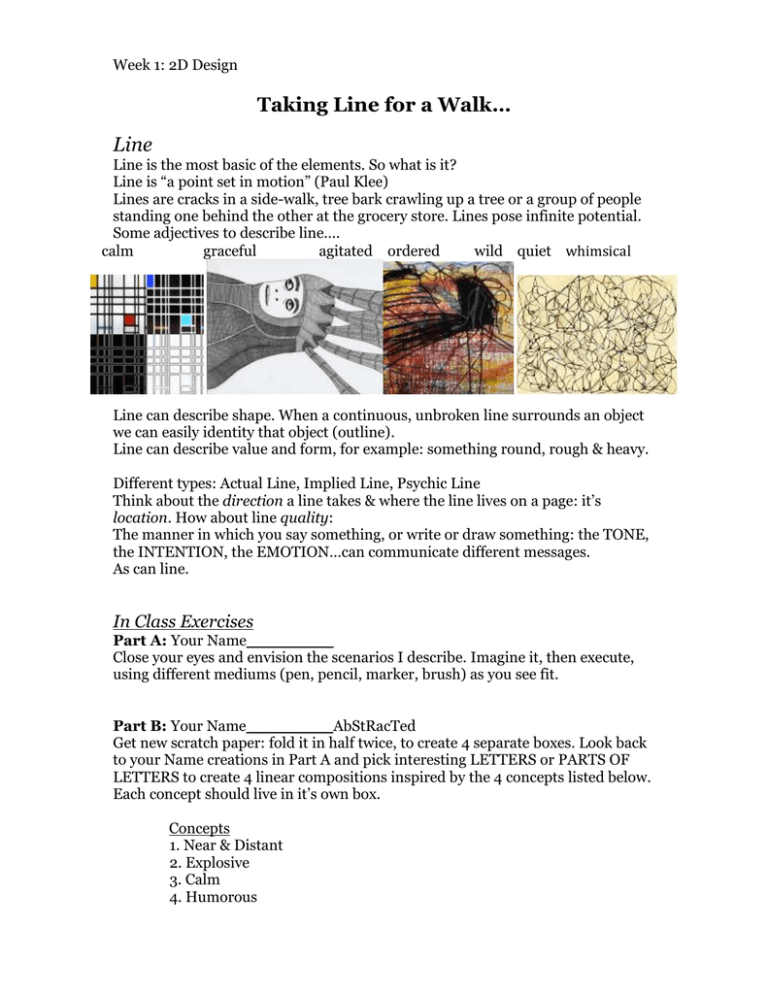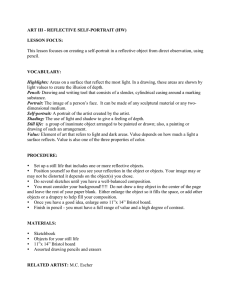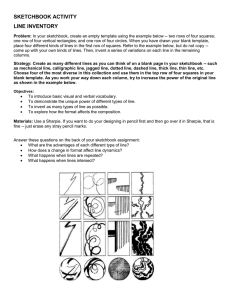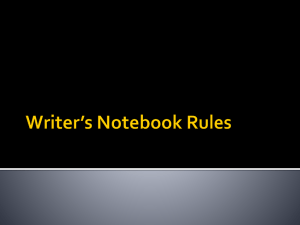Project 1.doc
advertisement

Week 1: 2D Design Taking Line for a Walk… Line Line is the most basic of the elements. So what is it? Line is “a point set in motion” (Paul Klee) Lines are cracks in a side-walk, tree bark crawling up a tree or a group of people standing one behind the other at the grocery store. Lines pose infinite potential. Some adjectives to describe line…. calm graceful agitated ordered wild quiet whimsical Line can describe shape. When a continuous, unbroken line surrounds an object we can easily identity that object (outline). Line can describe value and form, for example: something round, rough & heavy. Different types: Actual Line, Implied Line, Psychic Line Think about the direction a line takes & where the line lives on a page: it’s location. How about line quality: The manner in which you say something, or write or draw something: the TONE, the INTENTION, the EMOTION…can communicate different messages. As can line. In Class Exercises Part A: Your Name_________ Close your eyes and envision the scenarios I describe. Imagine it, then execute, using different mediums (pen, pencil, marker, brush) as you see fit. Part B: Your Name_________AbStRacTed Get new scratch paper: fold it in half twice, to create 4 separate boxes. Look back to your Name creations in Part A and pick interesting LETTERS or PARTS OF LETTERS to create 4 linear compositions inspired by the 4 concepts listed below. Each concept should live in it’s own box. Concepts 1. Near & Distant 2. Explosive 3. Calm 4. Humorous 2D Design Clarissa Gregory Part 1: Research & Sketchbook Entries Research & examine the way artists use and create LINE. If searching on Google, type in: Artist Name, drawing. Pay attention to line variety & quality. Pick two different artworks from two different artists and sketch them in sketchbook (list name of artist, materials used, date). Write a couple sentences talking about how the artist used line & what it communicates (expressive or technical). Part 2: Project #1 200 Straight Lines Make a composition indicating space non-objectively using only 200 straight lines (avoid drawing from life directly or anything representational). Consider the definition of the word “line.” Look it up in a dictionary, an art book, a geometry text. Think about these questions: What is a line? What is a straight line? What is a point on a line? How wide can a line get before it makes a shape? Can a line change width or value within itself? How long does a line have to be to qualify as a line? If a line ends at a certain point or runs off the picture plane, does it continue into space conceptually? Can one use straight lines to make curves? Materials needed: ruler, pencil, black pen/marker/ink, Bristol paper. Optional: white pencil/ink (on black paper) *Final Project must be BLACK INK/MARKER on Bristol Paper Practice in sketchbook with pencil first. Consider the size of your picture plane to the limitation of using only 200 lines. Utilize the space of the page and be creative with the limitation at hand. To indicate space, think about overlapping lines and lines that differ in scale, value, texture, and weight. Lighter, thinner lines will appear to be farther away than will heavy, dark lines. The implication of texture can be built up not only by the placement of the lines, but also by varying media. A complete range of values and rhythm can be attained by placing lines together; the ending points of lines become critically important. Try to activate the entire picture plane spatially by use of strong, dynamic composition. DUE:End of Week 2 Project #1: 200 Straight Lines 2 Sketchbook entries




